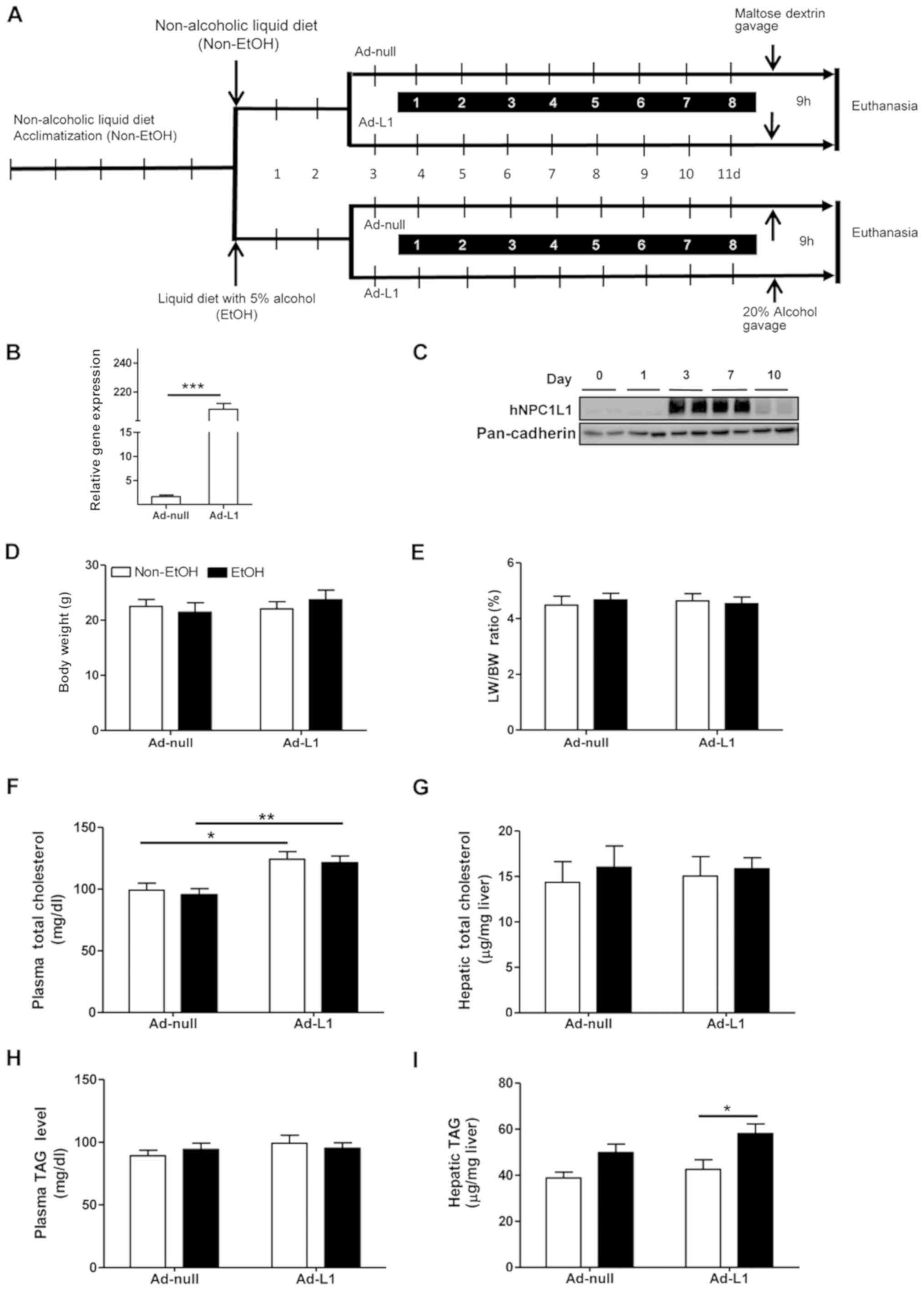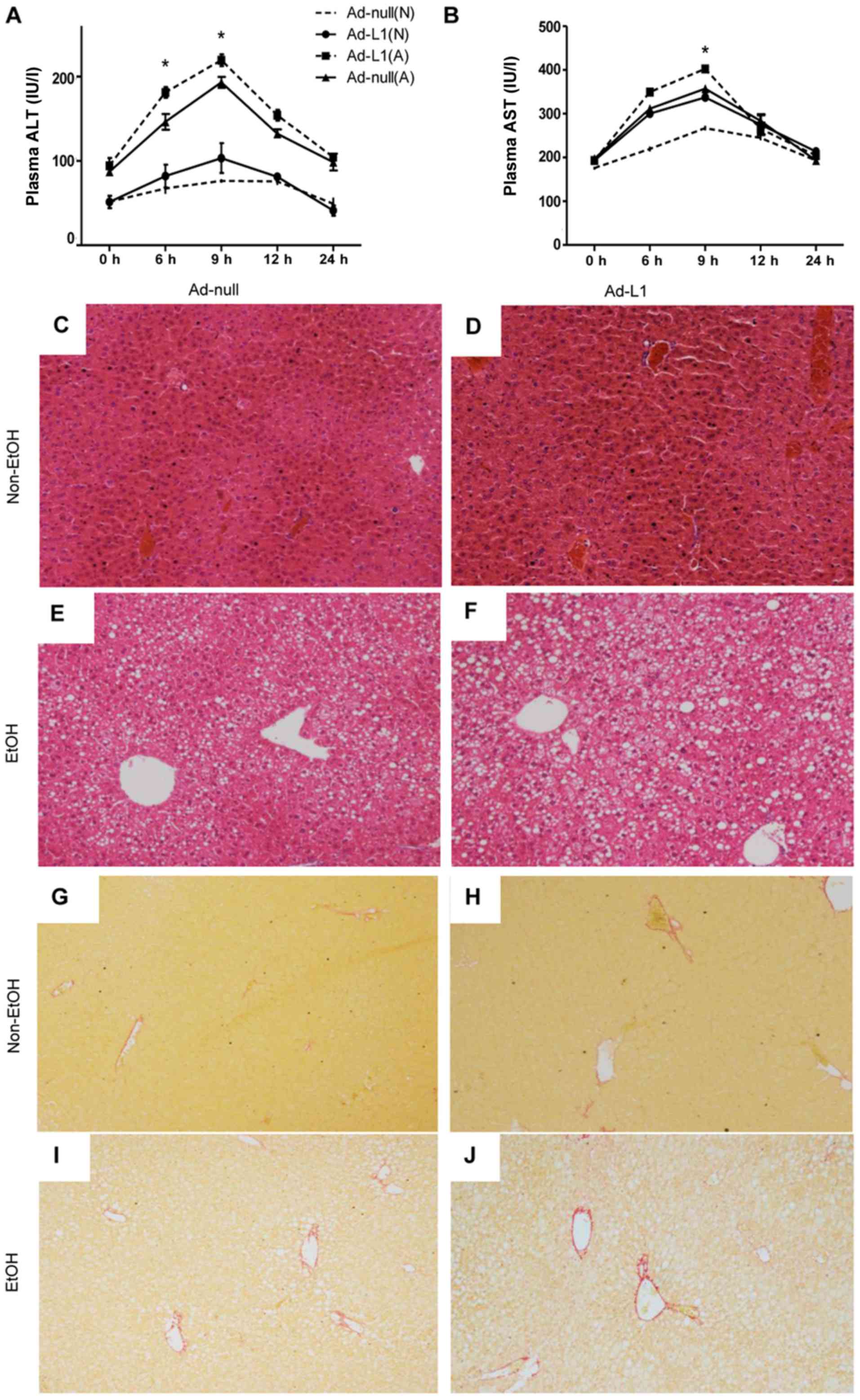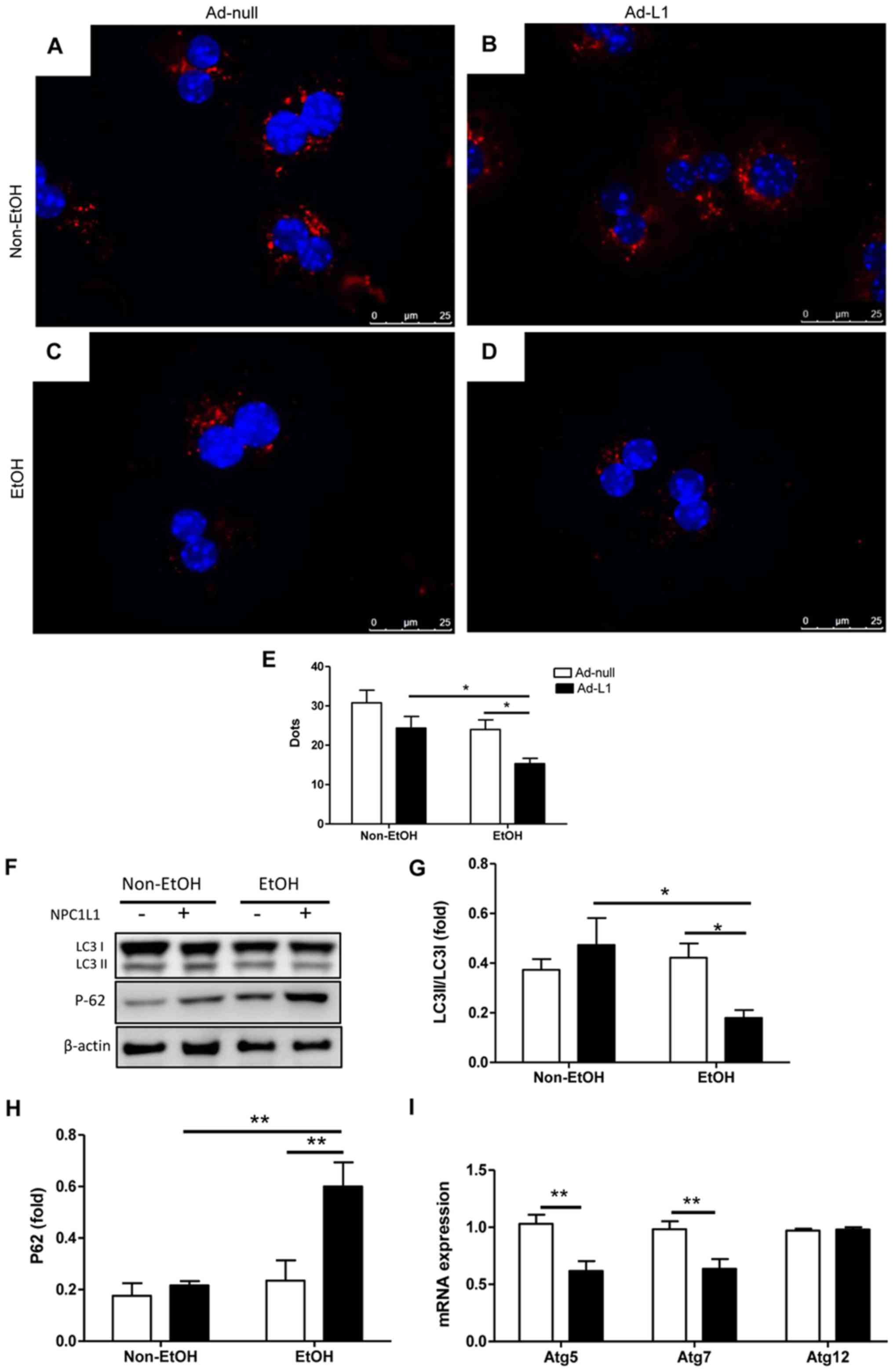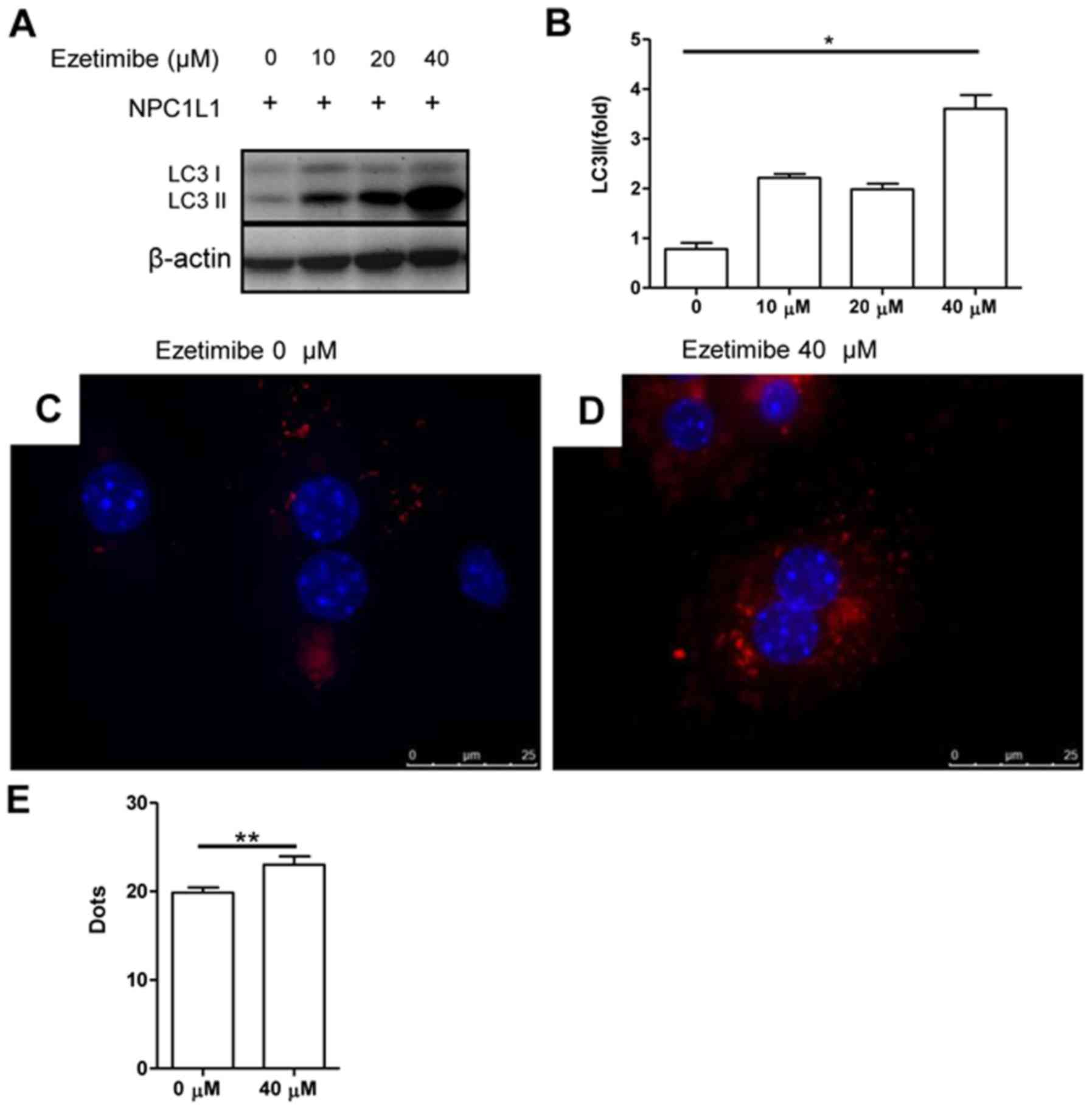|
1
|
Ishak KG, Zimmerman HJ and Ray MB:
Alcoholic liver disease: Pathologic, pathogenetic and clinical
aspects. Alcohol Clin Exp Res. 15:45–66. 1991. View Article : Google Scholar : PubMed/NCBI
|
|
2
|
Ramaiah S, Rivera C and Arteel G:
Early-phase alcoholic liver disease: An update on animal models,
pathology, and pathogenesis. Int J Toxicol. 23:217–231. 2004.
View Article : Google Scholar : PubMed/NCBI
|
|
3
|
Walther TC and Farese RV Jr: Lipid
droplets and cellular lipid metabolism. Ann Rev Biochem.
81:687–714. 2012. View Article : Google Scholar : PubMed/NCBI
|
|
4
|
Lass A, Zimmermann R, Haemmerle G,
Riederer M, Schoiswohl G, Schweiger M, Kienesberger P, Strauss JG,
Gorkiewicz G and Zechner R: Adipose triglyceride lipase-mediated
lipolysis of cellular fat stores is activated by CGI-58 and
defective in chanarin-dorfman syndrome. Cell Metab. 3:309–319.
2006. View Article : Google Scholar : PubMed/NCBI
|
|
5
|
Ding WX, Li M, Chen X, Ni HM, Lin CW, Gao
W, Lu B, Stolz DB, Clemens DL and Yin XM: Autophagy reduces acute
ethanol-induced hepatotoxicity and steatosis in mice.
Gastroenterology. 139:1740–1752. 2010. View Article : Google Scholar : PubMed/NCBI
|
|
6
|
Noh BK, Lee JK, Jun HJ, Lee JH, Jia Y,
Hoang MH, Kim JW, Park KH and Lee SJ: Restoration of autophagy by
puerarin in ethanol-treated hepatocytes via the activation of
AMP-activated protein kinase. Biochem Biophys Res Commun.
414:361–366. 2011. View Article : Google Scholar : PubMed/NCBI
|
|
7
|
Thomes PG, Ehlers RA, Trambly CS, Clemens
DL, Fox HS, Tuma DJ and Donohue TM: Multilevel regulation of
autophagosome content by ethanol oxidation in HepG2 cells.
Autophagy. 9:63–73. 2013. View Article : Google Scholar : PubMed/NCBI
|
|
8
|
Singh R, Kaushik S, Wang Y, Xiang Y, Novak
I, Komatsu M, Tanaka K, Cuervo AM and Czaja MJ: Autophagy regulates
lipid metabolism. Nature. 458:1131–1135. 2009. View Article : Google Scholar : PubMed/NCBI
|
|
9
|
Li Y, Wang S, Ni HM, Huang H and Ding WX:
Autophagy in alcohol-induced multiorgan injury: Mechanisms and
potential therapeutic targets. Biomed Res Int. 2014:4984912014.
View Article : Google Scholar : PubMed/NCBI
|
|
10
|
Rasineni K, Donohue TM Jr, Thomes PG, Yang
L, Tuma DJ, McNiven MA and Casey CA: Ethanol-induced steatosis
involves impairment of lipophagy, associated with reduced Dynamin2
activity. Hepatol Commun. 1:501–512. 2017. View Article : Google Scholar : PubMed/NCBI
|
|
11
|
Ni HM, Du K, You M and Ding WX: Critical
role of FoxO3a in alcohol-induced autophagy and hepatotoxicity. Am
J Pathol. 183:1815–1825. 2013. View Article : Google Scholar : PubMed/NCBI
|
|
12
|
Cheng J, Ohsaki Y, Tauchi-Sato K, Fujita A
and Fujimoto T: Cholesterol depletion induces autophagy. Biochem
Biophys Res Commun. 351:246–252. 2006. View Article : Google Scholar : PubMed/NCBI
|
|
13
|
Altmann SW, Davis HR, Zhu LJ, Yao X, Hoos
LM, Tetzloff G, Iyer SP, Maguire M, Golovko A, Zeng M, et al:
Niemann-Pick C1 Like 1 protein is critical for intestinal
cholesterol absorption. Science. 303:1201–1204. 2004. View Article : Google Scholar : PubMed/NCBI
|
|
14
|
Davis HR Jr, Zhu LJ, Hoos LM, Tetzloff G,
Maguire M, Liu J, Yao X, Iyer SP, Lam MH, Lund EG, et al:
Niemann-Pick C1 Like 1 (NPC1L1) is the intestinal phytosterol and
cholesterol transporter and a key modulator of whole-body
cholesterol homeostasis. J Biol Chem. 279:33586–33592. 2004.
View Article : Google Scholar : PubMed/NCBI
|
|
15
|
Temel RE, Tang W, Ma Y, Rudel LL,
Willingham MC, Ioannou YA, Davies JP, Nilsson LM and Yu L: Hepatic
Niemann-Pick C1-like 1 regulates biliary cholesterol concentration
and is a target of ezetimibe. J Clin Invest. 117:1968–1978. 2007.
View Article : Google Scholar : PubMed/NCBI
|
|
16
|
Davis HR Jr and Altmann SW: Niemann-Pick
C1 like 1 (NPC1L1) an intestinal sterol transporter. Biochim
Biophys Acta. 1791:679–683. 2009. View Article : Google Scholar : PubMed/NCBI
|
|
17
|
Wang Y, Tang W, Yang P, Shin H and Li Q:
Hepatic NPC1L1 promotes hyperlipidemia in LDL receptor deficient
mice. Biochem Biophys Res Commun. 499:626–633. 2018. View Article : Google Scholar : PubMed/NCBI
|
|
18
|
Tang W, Jia L, Ma Y, Xie P, Haywood J,
Dawson PA, Li J and Yu L: Ezetimibe restores biliary cholesterol
excretion in mice expressing Niemann-Pick C1-like 1 only in liver.
Biochim Biophys Acta. 1811:549–555. 2011. View Article : Google Scholar : PubMed/NCBI
|
|
19
|
Kurano M, Hara M, Tsuneyama K, Okamoto K,
Iso-O N, Matsushima T, Koike K and Tsukamoto K: Modulation of lipid
metabolism with the overexpression of NPC1L1 in mouse liver. J
Lipid Res. 53:2275–2285. 2012. View Article : Google Scholar : PubMed/NCBI
|
|
20
|
Yamamura T, Ohsaki Y, Suzuki M, Shinohara
Y, Tatematsu T, Cheng J, Okada M, Ohmiya N, Hirooka Y, Goto H and
Fujimoto T: Inhibition of niemann-pick-type C1-like1 by ezetimibe
activates autophagy in human hepatocytes and reduces mutant
α1-antitrypsin Z deposition. Hepatology. 59:1591–1599. 2014.
View Article : Google Scholar : PubMed/NCBI
|
|
21
|
Simpson IA and Sonne O: A simple, rapid,
and sensitive method for measuring protein concentration in
subcellular membrane fractions prepared by sucrose density
ultracentrifugation. Anal Biochem. 119:424–427. 1982. View Article : Google Scholar : PubMed/NCBI
|
|
22
|
Fischer AH, Jacobson KA, Rose J and Zeller
R: Hematoxylin and eosin staining of tissue and cell sections. CSH
Protoc 2008: pdb.prot4986. 2008.
|
|
23
|
Li WC, Ralphs KL and Tosh D: Isolation and
culture of adult mouse hepatocytes. Methods Mol Biol. 633:185–196.
2010. View Article : Google Scholar : PubMed/NCBI
|
|
24
|
Livak KJ and Schmittgen TD: Analysis of
relative gene expression data using real-time quantitative PCR and
the 2(-Delta Delta C(T)) method. Methods. 25:402–408. 2001.
View Article : Google Scholar : PubMed/NCBI
|
|
25
|
Ding W X, Manley S and Ni HM: The emerging
role of autophagy in alcoholic liver disease. Exp Biol Med
(Maywood). 236:546–556. 2011. View Article : Google Scholar : PubMed/NCBI
|
|
26
|
Dolganiuc A, Thomes PG, Ding WX, Lemasters
JJ and Donohue TM Jr: Autophagy in alcohol-induced liver diseases.
Alcohol Clin Exp Res. 36:1301–1308. 2012. View Article : Google Scholar : PubMed/NCBI
|
|
27
|
Tang W, Ma Y and Yu L: Plasma cholesterol
is hyperresponsive to statin in ABCG5/ABCG8 transgenic mice.
Hepatology. 44:1259–1266. 2006. View Article : Google Scholar : PubMed/NCBI
|
|
28
|
Ki SH, Park O, Zheng M, Morales-Ibanez O,
Kolls JK, Bataller R and Gao B: Interleukin-22 treatment
ameliorates alcoholic liver injury in a murine model of
chronic-binge ethanol feeding: Role of signal transducer and
activator of transcription 3. Hepatology. 52:1291–1300. 2010.
View Article : Google Scholar : PubMed/NCBI
|
|
29
|
Bertola A, Mathews S, Ki SH, Wang H and
Gao B: Mouse model of chronic and binge ethanol feeding (the NIAAA
model). Nat Protoc. 8:627–637. 2013. View Article : Google Scholar : PubMed/NCBI
|
|
30
|
Betters JL and Yu L: NPC1L1 and
cholesterol transport. FEBS Lett. 584:2740–2747. 2010. View Article : Google Scholar : PubMed/NCBI
|


















